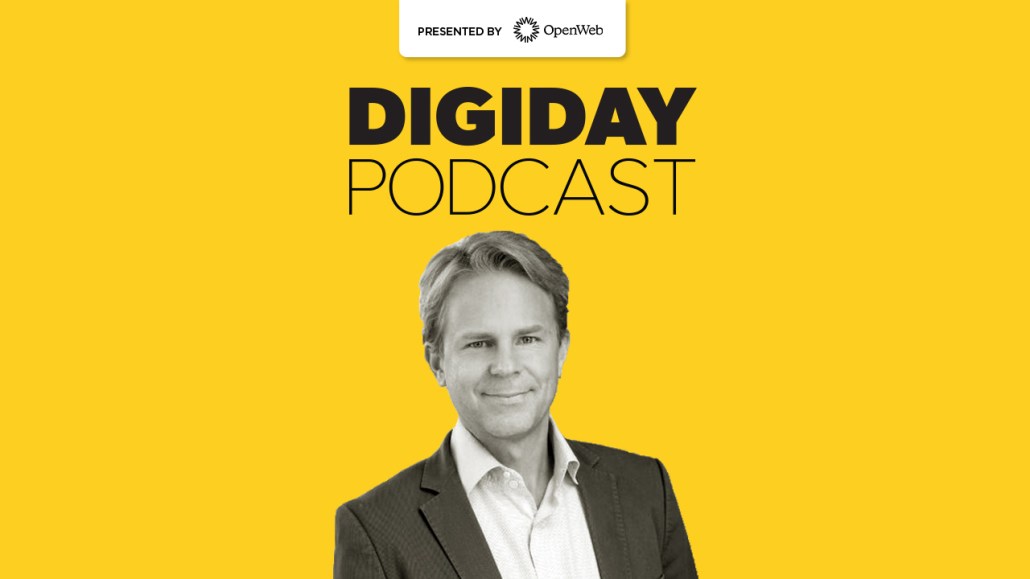‘Significant growth’: Bloomberg Media Group CEO Justin Smith on the accelerated shift to subscriptions

Subscribe: Apple Podcasts | Stitcher | Google Play | Spotify
Subscriptions are gaining ground as a major source of revenue for Bloomberg.
“We’re seeing significant, significant growth and gains,” Bloomberg Media Group CEO Justin Smith said at the Digiday Publishing Summit.
And that growth in the first and second quarter has proven sticky, according to Smith. “Some of the churn rates are consistent with previous churn rates. This is not just a short-term thing,” he said.
His forecast is that subscriptions will make up a rising and significant part of Bloomberg’s revenue, especially as income from advertising diminishes.
Bloomberg started its subscription business in May 2018, and Smith credits its “first phase” growth to the long brand-building that preceded it.
“The introduction of our paywall benefited from 25-30 years of Bloomberg LP growing out one of the largest newsrooms in the world, creating amazing content,” Smith said.
His outlook for future revenue also lies in live events, and he’s confident that the events business “will come back very, very strongly” once it’s safe to convene in big groups again.
“There’s a big opportunity to capture more market share as we go through this lost year in events — to come back with a much more aggressive slate of event programming and also a whole new range of opportunities tied to virtual events, which will become much more of a complement to the live event experience.”
Here are highlights from the conversation, which have been lightly edited for clarity.
No health, no wealth
“My personal view is that the economic situation — to which advertising spending is directly tied — is derivative of the public health situation. As long as the public health situation is not under control or the trend lines are negative, the economic metrics which affect advertising spending are going to follow suit. We’re not counting on a rapid bounce-back in Europe or in the U.S., though we’re a little more confident — both timing wise and in terms of how they’ve managed the public health situation — in our Asian and our European outlook than we are in our U.S. outlook.”
Facebook and the like will (yet again) win
“The difference between advertising and live events it that advertising was already facing significant headwinds across the last couple of years, especially digital advertising. My view is that the pandemic, to a large extent, is going to accelerate those negative trends on digital advertising. The platforms, even though they’re facing relative difficulties this year, they are going to increase their strength and market share out of this pandemic. In an environment where CMOs have less dollars to spend, the scale and the performance metrics and efficiencies of the platforms will prove very attractive. Unfortunately, the publishing business has not yet come up with alternative advertising models that are competitive.”
The silver lining: subscriptions are up
“This is a time when you can lean into some of the revenue streams that are being promoted by some of these lifestyles changes and work from home dynamics. We are seeing major increases in subscription revenue. We’re even seeing signs that the big bumps in subscription revenue across the first and second quarter due to the increase news consumption actually are sticking around.”
Advertising revenue won’t just disappear
“There’s a lot of conversation around pulling back from advertising — the idea that we should divest from advertising. We think the advertising business will continue to be a viable business, in terms of ‘how do you modernize and transform your ad business for post-platform work? If we’re honest, as an industry, I’m not sure any of us get great marks for the amount of innovation or new solutions that we’ve brought to the advertising marketplace. Particularly if you deliver on audience segments that are targeted and niche, with better execution around first-party data and integration of marketing services, I think there’s a viable ad business in a post-platform world to be built.”
Publishers haven’t innovated at the speed of big tech
“There’s a talent gap around advertising, data, technology, engineering that exists between publishers and platforms. It’s very much a David versus Goliath dynamic when you think about the numbers and types of people trying to solve these marketing challenge at platforms versus publishers. Of course, it’s a reinforcing deficiency: the more the businesses have been challenged by the platforms, the more market share has been taken away, the less resources exist to invest in this area. I’d largely say it’s a talent and resource question, and one which because of that, is very difficult to solve.”
Join us on Friday, July 10 at 12 p.m. ET on The New Normal, a weekly interactive show focused on how publishers are adapting their businesses. Team Epiphany founder Coltrane Curtis will talk with Digiday editor-in-chief Brian Morrissey about connecting with the influencers who truly shape culture. Register here.
More in Media

Meta AI rolls out several enhancements across apps and websites with its newest Llama 3
Meta AI, which first debuted in September, also got a number of updates including ways to search for real-time information through integrations with Google and Bing.

Walmart rolls out a self-serve, supplier-driven insights connector
The retail giant paired its insights unit Luminate with Walmart Connect to help suppliers optimize for customer consumption, just in time for the holidays, explained the company’s CRO Seth Dallaire.

Research Briefing: BuzzFeed pivots business to AI media and tech as publishers increase use of AI
In this week’s Digiday+ Research Briefing, we examine BuzzFeed’s plans to pivot the business to an AI-driven tech and media company, how marketers’ use of X and ad spending has dropped dramatically, and how agency executives are fed up with Meta’s ad platform bugs and overcharges, as seen in recent data from Digiday+ Research.





